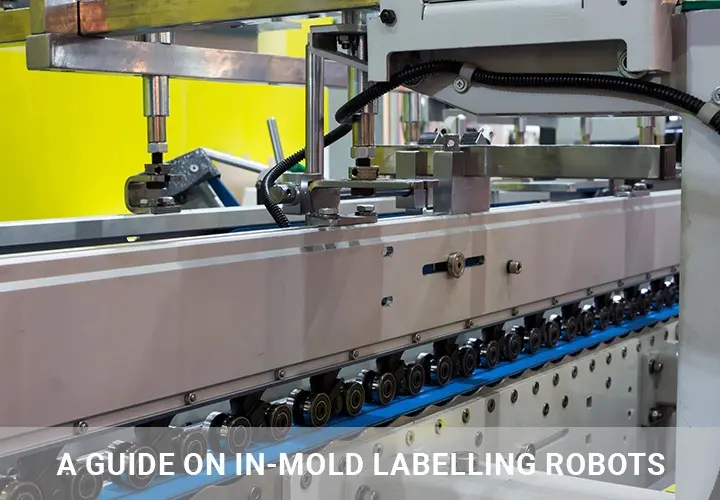
In today’s rapidly evolving plastic industry, automation has become indispensable for optimizing processes and maximizing efficiency. In-Mold Labeling (IML) robots represent a pinnacle of innovation within the injection molding process, offering unparalleled precision, speed, and versatility. In-Mold Labeling Robots (IML Robots) are cutting-edge industrial automation solutions designed to streamline the process of labeling molded products directly within the mold cavity during the injection molding process. This innovative technology offers several advantages over traditional post-molding labeling methods, including increased efficiency, improved product quality, and enhanced flexibility.
IML robots are equipped with advanced robotic arms, precision vision systems, and sophisticated control systems, allowing them to handle and place labels with utmost accuracy and consistency. The process involves inserting pre-printed labels or films into the mold cavity before injecting molten plastic, thereby seamlessly integrating labeling into the molding cycle. Unlike traditional post-molding labeling methods, IML robots insert labels directly into the mold cavity before injection, resulting in a fully automated labeling process. With the use of sophisticated technologies like robotic arms, vision systems, and programmable logic controllers (PLCs), these robots are able to precisely insert labels and coordinate with injection molding equipment.
Check out the related products: Top Entry IML Robots and Side Entry IML Robots
How In-Mold Labeling Technology Works
For manufacturers optimizing their production lines, understanding the workings of in-mold labeling robots is crucial. The process is a perfectly sequenced integration of cutting-edge robotics and intelligent automation.
When an injection molding machine triggers the robotic system, the system begins its labeling cycle. The robotic vision system analyzes the mold cavity and identifies pre-defined alignment and marker points. The robotic arm receives this instant visual feedback as part of the closed-loop system and determines the path for label placement. The label, which may be a pre-printed film, foil, or specialty material, is positioned and inserted into the mold cavity just before the injection of molten plastic.
Delta Stark’s IML robotic solutions are particularly effective due to their perfectly sequenced and timed integration with injection molding equipment. Our robotic systems are designed to perform cycle times of manual labeling while exceeding expected accuracy and consistency.
Whether you’re utilizing our top-entry IML labeling system or our side-entry IML solution, both configurations are engineered to maximize production throughput without compromising label quality.
The integration of intelligent PLCs ensures that every movement is optimized, reducing idle time and waste. This level of automation sophistication transforms the manufacturing process, turning what was once a labor-intensive, error-prone operation into a streamlined, predictable workflow.
Key Components and Features of In-Mold Labeling Robots:
- Advanced vision systems utilize cameras and sensors to detect mold features and guide the robotic arm with pinpoint accuracy during label placement.
- PLCs serve as the control center, orchestrating the movements and operations of IML robots in synchronization with injection molding machines.
- Specialized attachments, such as grippers or suction cups at the end of the robotic arm, facilitate the handling and placement of labels within the mold.
- IML robots feature standardized communication interfaces, allowing seamless integration with injection molding machines and other industrial automation equipment.
- IML robots are equipped with multi-axis robotic arms capable of intricate movements for precise label insertion into the mold cavity.
IML robots play a crucial role in automating the labeling process within injection molding operations, leading to significant improvements in efficiency, productivity, and product quality. By eliminating manual labeling tasks, these robots streamline production processes, reduce cycle times, and increase throughput. Furthermore, automation improves the overall quality of molded items by achieving precision and consistency, which boosts customer satisfaction and brand reputation.
Additionally, IML robots enable plastic manufacturers to adapt quickly to changing market demands, thanks to their flexibility in handling various label sizes, shapes, and materials.
Benefits of In-Mold Labeling Robots:
- Automation of the labeling process reduces cycle times and increases production throughput, maximizing operational efficiency.
- Precise label placement ensures consistency and accuracy, resulting in higher-quality molded products with minimal defects.
- IML robots can handle a wide range of label sizes, shapes, and materials, enabling manufacturers to diversify their product offerings and meet evolving customer demands.
- Through the optimization of manufacturing processes and the reduction of manual labor, IML robots eventually lead to cost savings and increased profitability.
- Automation reduces the risk of workplace accidents associated with manual labeling tasks, enhancing workplace safety and employee well-being.
Also read: Benefits of Side Entry IML Robots
The Evolution of IML Robot Technology and Industry Applications
The last decade has brought major advancements in the in-mold labeling industry. Modern IML robots integrate advanced robotics with computer vision and industrial control systems. This integration allows across many industries to reach previously unattainable production thresholds.
Current applications go far beyond the legacy plastic containers. IML in-mold labeling robots are essential in the automotive industry, in consumer electronics, and in the packaging of food and pharmaceuticals. Operational efficiencies and improvements in quality returns on labeling automation investments have led many manufacturers to embrace automation.
Delta Stark’s IML robots expertise comes from years of carefully grounded industry research, development, and extensive practical application. Our systems are designed to address the particular and difficult obstacles presented by manufacturers: disparate label materials, intricate shapes, demanding turn-around times, and the need for uniformity at speed.
Adaptability is one of the greatest IML technology in-mold labeling innovations. Today’s robotic systems can be flexibly aligned to suit differing requirements of pressure sensitive labels, heat transfer films, and rigid foil materials. This versatility is of great importance to manufacturers targeting multiple market segments and those with seasonal changes in their products
Conclusion:
In-Mold Labeling Robots represent a paradigm shift in plastic industry automation, offering a synergistic blend of precision, efficiency, and flexibility within injection molding processes. By embracing automation and leveraging advanced technologies, manufacturers can streamline operations, improve product quality, and achieve sustainable growth in today’s competitive market landscape. As the plastic industry continues to evolve, IML robots will undoubtedly remain indispensable tools for driving innovation and operational excellence.
